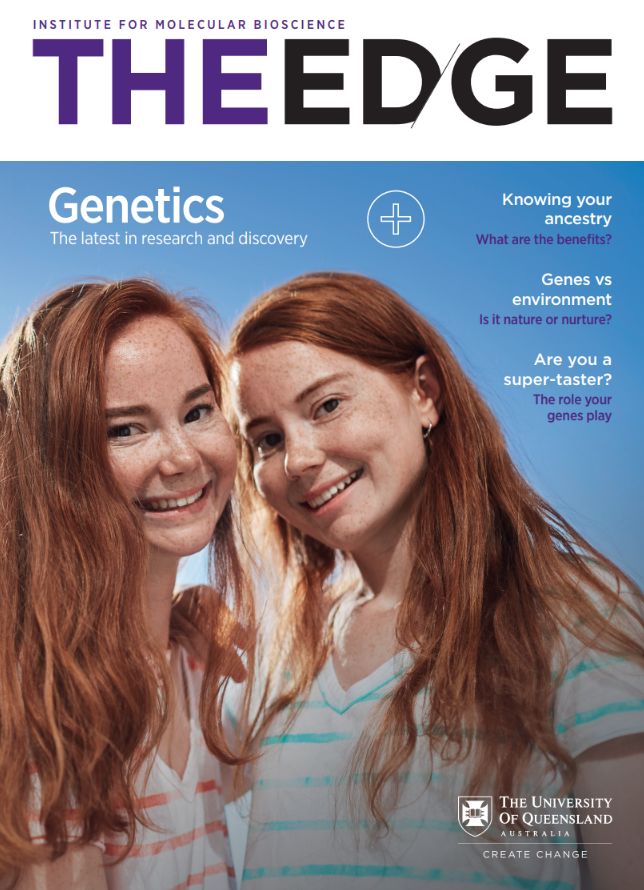How are we influenced by our genes as opposed to our environment?
For some traits, genes play a very big role – for example, our height is determined 80 per cent by heritability, 20 per cent by our environment – and for other traits, the genetic influence is much smaller, like the number of children you have.
Researchers at IMB are helping resolve this long–running debate by quantifying the relative role of genes versus the environment for various traits.
Associate Professor Allan McRae explains why it is important to study the role of genes, even if there is only a small genetic component to a disease.
“If genes only play a small role, investigating their influence still gives us clues about the biology of the disease and starts to build up a complete picture – it also gives us ideas for potential drug targets.
“It’s important to understand that genes and the environment are not entirely independent – the environment can be influencing your genes, determining if they are turned on and off.”

Epigenetics – the environment influencing genes
So how does the environment affect our genes? This is where the field of epigenetics – changes to our DNA in response to our environment – comes in.
These epigenetic changes affect how cells use our DNA sequence, which in turns affects the production of proteins, which underlie nearly every biological process in our body. Epigenetic changes in response to the environment can potentially be reversible.
One change that occurs is when chemicals are added to our DNA. The most common chemical addition is methylation, when a molecule with a central carbon atom bonded to three hydrogen atoms – a methyl group – is added. Methylation is one of the ways in which cells control gene expression, i.e. turn genes on and off.

Another epigenetic change is when modifications occur to histones, which are the proteins around which DNA wraps. Every cell has a different pattern of methylation and histone modification, known as an epigenome.
“The epigenome gives a really interesting insight to a person’s environment because it tends to get wiped at conception, so isn’t inherited from your parents, and changes with age, environmental exposure and disease, meaning you can study how it has changed over time.” – Dr Allan McRae

Using the epigenome to predict age
Using the epigenome to predict age “One thing we can do with the epigenome is to predict age, and there’s a lot of research now into comparing people’s real age with their ‘methylation age'.“People with a higher methylation age than their actual age have a higher risk of disease or may die younger, but maybe that can be reversed by leading a healthier lifestyle.”
Predicting age using the epigenome could also have applications in forensics.
“Scientists could study the DNA of an unidentified body and use the epigenome to give an estimate of how old the person was when they died – we have an accuracy margin of about 5 years currently.”
Epigenetics and disease
Dr McRae has a particular interest in epigenetics in neurodegenerative diseases such as motor neurone disease, Alzheimer’s and Parkinson’s diseases and also schizophrenia.“The DNA is methylated at thousands of points across the genome so you compare the patterns in healthy people with the patterns in people with a disease or trait and find the differences.
“We don’t know if the methylation is a cause or a consequence of the disease but the methylation still focuses around genes of interest – it gives us clues about how the disease works and potential targets for drugs.”
Epigenetics and smoking
Dr McRae and his colleagues have used epigenetics to look at methylation patterns in the DNA of smokers versus non-smokers.
“We found very big variations in methylation between smokers and non-smokers. Some of the variations that occurred due to smoking are reversible and some are still there 20 years after someone stopped smoking,” Dr McRae said.
“Some methylation was heavily clustered around a hydrocarbon receptor – a gene that makes the protein that deals with detoxification of chemicals that you inhale when you are smoking.
“Sometimes the methylation pattern of a non-smoker looks like that of a smoker, then we discover that they live with a heavy smoker. Epigenetics doesn’t lie – the person may not be lifting a cigarette to their lips but they are actually passive smoking and have the same amount of damage to their DNA as a smoker.”

Environment is unpredictable and hard to control
Some environmental changes to our DNA are reversible – we can stop smoking, embrace a healthy lifestyle and reduce our stress in an effort to keep our DNA methylation down so we have a lower “methylation age”.Through evolution, epigenetics has allowed us to adapt quickly to our environment and for researchers and philosophers, it further blurs the distinction between what is influenced by our genes and what is influenced by our environment.

